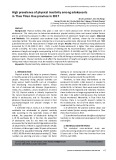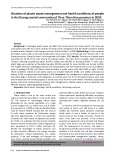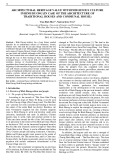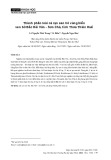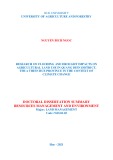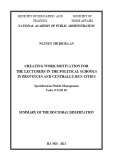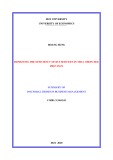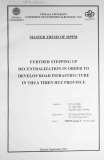1 INTRODUCTION
1. Rationale of this research Tourism is growing rapidly, bringing high socio economic and environmental efficiency of many countries in over the world. Tourism has become the key economic sector in Viet Nam thanks to divers and abundant tourism resource. The fact of tourism growth in our country shows that a proper and judicious evaluating and exploitating not only promote economic development but also contribute on conserving stable resource.
Thua Thien Hue (TTH) is one of the few regions which have divers and abundant tourism resources, especially the special and high humanity tourism resources. This is the land of history, culture, and the political, culture, economic center of our country in more than 3 centuries. Nowadays, TTH still remains many cultural heritages which feature for spirit and wisdom of Vietnamese race, becomes the precious heritage of the nation and one of its’ important part was recognized as a cultural heritage of the world.
The fact is that the humanity tourism resource exploitation in over decade achieved many accomplishments but its' economic efficiency is still poor due to monotonous tourism products and mainly exploiting some resources belonging the Complex of Hue Monuments. Therefore, inventorying and evaluating tourism exploiting possibility for resource is necessary in order to have rational and more effective exploiting orientations and solutions in the future. That is the reasons for the author to choose the research project: “The evaluation of humanity tourism resource in Thua Thien Hue province” for my Geography doctoral thesis. 2. Literature review
In the world, the theoretical and practical issues of humanity tourism resource and evaluating them have been mentioned in many studies such as: Cultural resources for Tourism: Models, process and Policy, Myriam Jansen Verbeke et el (2008); Operational Guidelines for the Implementation of the World Heritage Convention, UNESCO (2001); Sustainable Tourism Management , John Swarbrooke (2000), Linking communities tourism and conservation A tourism assessment process, Elleen Guierrez,… In Vietnam, the theories of humanity tourism resource has been mainly researched in geographical aspect with a special meaningful study: “Viet Nam tourism
2
geography", Nguyen Minh Tue (chef editor, 2000). Many studies tend toward organizing tourism territory and evaluating tourism resource, including arranging humanity tourism resource in local and provincial scale.
Humanity tourism resources in TTH are considered in many aspects: History, culture, architecture, art, religion,… Plans on tourism development, assessment of tourism resources, plans on tourism territory, evaluation of cultural historical relics,… have been provided a lot of information and hints for the author.
Generally, humanity tourism resources and evaluating them are interested and researched in many different aspects. However, evaluating comprehensively on humanity tourism resources of TTH according to tourism resource sites have not had anystudy researched systematically. 3. Research object and tasks 3.1. Research object
The thesis aims to assess humanity tourism resources of Thua Thien Hue province. Basing on the findings to propose recommendations on orientations and solutions to exploit effectively humanity tourism resources and satisfy sustainably growth requirements of TTH tourism in the future. 3.2. Research tasks
To review key theoretical and practical issues related to humanity tourism resources, evaluating humanity tourism resources to apply them to concrete conditions of the research area. To identify suitable criteria to assess humanity tourism resources in TTH province;
To analyze characteristics of humanity tourism resources in TTH; To evaluate humanity tourism resources sites of TTH for tourism development. To analyze situation of exploiting humanity tourism resources in TTH.
To propose orientation of developing toward tourist sites, routes and solutions in order to exploit effectively humanity tourism resources in TTH in the future. 4. Research scope Content scope:
3 The thesis focus on inventorying, analyzing generally humanity tourism resources in TTH, including cultural historical relics; festivals; objects related to ethnology; traditional craft villages; objects of cultural, sports and other awareness activities.
Comprehensive scale method is used to evaluate resrearch objects that are fixed space objects. Basing on resources inventory and to set off traditional specific values of TTH province, the thesis chooses resource sites to assess upon comprehensive scale.
+ Cultural historical relics: The thesis assesses all of rated relics + Traditional craft villages: The thesis assesses traditional craft villages oriented on tourism developing, which is belong to Project “The plan on craft and craft village growth in TTH boundary to 2020 and orientation to 2025” and some traditional craft villages that are attractive for tourists at present.
+ Festivals, tourism subjects related to ethnology, cultural, sport and other awareness objects: The thesis assesses resources attracted to tourists.
The humanity tourism resource sites have comprehensive assessment consequence with medium level or more will be conducted to plan exploitation orientation by tourism sites and routes.
Spatial scope: The thesis analyzes generally humanity tourism resources and evaluates humanity tourism resource sites within boundary of TTH’s territory, and plans orientation of exploiting them not only within space of the province but also linked to the neighboring provinces. Time scope: The thesis evaluates humanity tourism resources of TTH at present, studies on situation of tourism growth and exploities humanity tourism resources of TTH in the period of 2000 2013 and proposes orientations, solutions to exploit effectively resources till 2030.
5. Research approaches and methods The five research approaches were used as follows: synthetic, systematic, spatial, historical perspective and sustainable development
The following methods were applied: secondary data collection; survay research; expertise; statistics; field trip; mapGIS; SWOT analysis 6. Contributions and New Findings
4 Having contributed to clarify the theory of humanity tourism resources and humanity tourism resources assessment, on that basis, the thesis have established procedure, theory framework to assess them. Having introduced system of criteria, indicators and weights of criteria for evaluating humanity tourism resources.
Having set off the value of humanity tourism resources in TTH and spatial differentiation of resources; identifing capacity of exploiting humanity tourism resources of the province to base for constructing orientation to exploit resources to offer tourism development more suitably.
Analyzed the advantages and difficulties of exploiting humanity tourism resources in TTH under the view of state administration agencies (management sector), tourism companies and tourists
Having proposed some orientations and solutions in order to exploit effectively resources to promote tourism development in TTH untill 2030.
7. Research structure Apart from the introduction and conclusions, references and appendices, the content of the thesis consists of three chapters: Chapter 1: Theoretical and practical background of evaluating humanity tourism resources. Chapter 2: Humanity tourism resources and evaluating humanity tourism resources in Thua Thien Hue.
Chapter 3: Orientations and solutions to exploit effectively humanity tourism resources in Thua Thien Hue
CHAPTER 1: THEORETICAL AND PRACTICAL BACKGROUND OF EVALUATING HUMANITY TOURISM RESOURCES
1.1. Theoretical background 1.1.1. Some basis concepts
Tourism means activities connected with trips taken by people outside their habitual residences aimed at satisfying their needs for sightseeing, study, leisure or recreation in a certain period of time
5 Tourists means a person who travels for either tourism or for other purposes combined with tourism, except for those who go to study, work or practice their professions to get paid at the places of destination Tourist product means a combination of necessary services provided in order to meet the needs of tourists during a trip
Tourism types is a set of tourist products having the same identities of needs, motives, customers, distributing wa , organizing way, cost,...
Tourism resources means natural landscapes, natural elements, historical or cultural relics, works of creative human labor or humanity values which can be utilized to meet tourist needs and constitute a fundamental factor to form tourist resorts, tourist spots, tourist routes or tourist cities
Tourist site and tourism resource site: Tourism resource site considered as places that have some types of tourism resources. Tourist spot are places that are attractive tourism resources and being exploited to offer tourists’ visit needs. 1.1.2 Humanity tourism resources 1.1.2.1. Definition: Humanity tourism resource includes cultural traditions and factors, folk art, historical relics, revolutions, archeological works, architectures, labour works of human creativities and the other intangible and tangible cultural heritages, can be used for tourism purposes. 1.1.2.2. Characteristic: Humanity tourism resources have the following characteristics: Universality; specificity; diversity and abundance; tangible and intangible valuation; difference in exploiting time; restorableness, changeability and creatability; centralization and accessibility; more cognitive than entertaining and resting. 1.1.2.3. Classify: Humanity tourism resources are divided into following groups: Cultural historical relics, festivals, subbject sassociated ethnology, traditional craft villages, other cultural, sport objects and awareness activities. Also, humanis recognized with the honour equivalent with the value levels of world, nation….). 1.1.3. Evaluating humanity tourism resources 1.1.3.1. Approaches of evaluating humanity tourism resources Evaluation orientations: Quantities and qualitative
6 Evaluation process: There are 3 steps: building evaluation scale,
conducting evaluation and assessting consequence 1.1.3.2.
Criteria and indicators to assess humanity tourism resources
Criteria
* Choosing criteria: There are 6 criteria used to evaluate humanity tourism resources to apply to TTH provinces as follows: Attractiveness, accessibility, connectiveness, conservation level, exploitation time and tourist carrying capacity. Grade level indicators: Humanity tourism resource sites are assessed into five level as follows
Table 1.1. Grade assessment criteria of humanity tourism resources Grade level
1. Attractiveness
Very attractive
Attractive
Medium
Less attractive
Unattractive
Tourism resource rank and famous level toward tourist.
The tourism resource placesthat its’ reputation and value exceed over Vietnamese territory, are wellknown in over the world or are world ranked level and dosmeticallywel lknown.
Tourism resource sites are world ranked but their reputation and value is just well known by local tourists or districted tourists or tourists of neighbor districs; For unranked resource sites, their reputation and value must be wellknown by provincial tourists.
Tourism resource placesare ranked from special nation rank updown and its’ reputation , value is wellknow in the coutry ; or are worldranked and wellknown in the province. Tourism resource places which have not been ranked are considered attractive if the reputation and value are dosmetically wellknown
Tourism resource sites are nationally ranked but their reputation and value are just wellknown by local tourists; or resource sites are nationally ranked and their reputation and value are wellknown by districted tourists or tourist of neighbor districts For unranked resource sites, their reputation and value must be wellknown by local tourists.
Less advantageous
Tourism resource sites are nationally ranked or povincially ranked but their reputation and value are wellknown by local tourists; or resource sites are princially ranked and their reputation and value are wellknown by districted tourists or tourist of neighbor districts For unranked resource sites, their reputation and value are just well known by local tourists. Disadvantageous
2. Accessibility
Advantageous
Medium
Distance
Far
Very far
Very advantageous Very near
Near
Medium
Under 10kms
Form 10 – 30 kms
Form 30 – 50 kms
Form 50 – 70 kms
More than 70kms
From resource sites to provincial administration center Vehicles
Very many
Many
Medium
few
Very few
Number of vehicles
5 verhicles
4 verhicles
3 verhicles
2 Verhicles
1 Verhicle
Quality of road
Very good
Good
Medium
Bad
Bery bad
Percent of roads with asphalt
100%
Form 90100%
Form 8090%
Form 7080%
<70%
Approach time
Very short
Short
Medium
Long
Very long
< 30 minutes
From 3060 minutes
From 6090 minutes
From 90120 minutes
< 120 minutes
Average time to travel from the center to resource sites 3. Connectiveness
Very good
Good
Medium
Bad
Bery bad
≥ 5 sites
4 sites
3 sites
2 sites
1 sites
Number of vicinal resource locatons 4. Conservation level
Very high
High
Medium
low
Very low
Status of works or Situation of craft village work
Quiet intact resource and they still remain their genius and identities
Which almost unexist or unexist in the field or are lost (for the craft)
Intact or nearly intact resource; craft villages are in good operation
Some geniuses and identities of resources are losing; craft villages operate
Most of geniuses and identities of resources are losing ; craft villages almost not operate and are
perfunctorily
in danger of losing
5. Tourist carrying capacity Very large
Large
Medium
Low
Very low
Form 100200 person/dayUnder 100 Person/day
Number of arivals that can be receive a day 6. Exploitation time
≥ 500 person/day Very long
From 300500 person/day Long
Form 200300 person/day Medium
Short
Very short
≥ 250 days/year
200250 days/year
Under 100 days/year
Number of day to organize tourism activities
Form 150200 days/year
Form 100150 people/day days/year
7
(cid:0)
* Weights: Analytic Hierarchy Process (AHP) is used to determine the weights of criteria through 8 experts’ review. Consequently, the weights of criteria are listed as follows: Attractiveness 0,32; Accessibility 0,19; Connectiveness 0,13; Conservation level 0,22; Tourist carrying capacity 0,06 and Exploitation time 0,08.
* Partial and synthetic assessment ladder Every criteria is divided into 5 levels with the equivalent score from the top down is 5, 4, 3, 2, 1.
The consequence of humanity tourism resource assessment is divided into five classes equavelent with exploitation capacity of very high, high, medium, low, very low. 1.2. Practical backgrounds
The implementation practice of humanity tourism resources evaluation in the world: Organizations and nations in the world such as Egypt, Canada, Romani, Philippines, Cambodia,… are very interested in humanity tourism resources assessment for preservation, exploitation for tourism development and planning. UNESCO is the most prestigious organization and brings global value for resources with world cultural heritages and other hornourable names as intangible cultural heritages of human and world document heritages. Besides, international organizations and websites such as New Open World Corporation (NOWC), CNN travel,... assess resources according to votes for world wonder, tasty foods, … basing on opinions of tourist and the people.
The implementation practice of humanity tourism resources evaluation in Vietnam: Assessment to rate resources value has been carried out on a nation scale and in the provinces and cities to base serve as base for resources preservation and promotion for tourism. In the tourism development plans and strategies for country, regions and areas, humanity tourism resources inventory and assessment are the growth power which base for building orientations and solutions of tourism.
8 Some issues of humanity tourism resources assessment: Resources assessment bases for planning tourism development, building steering overviews and principles for tourism inventory, assessment and management, establishing professional research organizations of assessment and prioritized investment in resources exploitation, promoting resources value associated with preservation, coordination between administration agencies and local community in resources management, exploitation and preservation
CHAPTER 2: HUMANITY TOURISM RESOURCES AND EVALUATION OF HUMANITY TOURISM RESOURCES IN THUA THIEN HUE PROVINCE
2.1. Introduction on Thua Thien Hue 2.1.1. Location and territory
Thua Thien Hue locates in the center of the most wealthy world heritage region of our country with area of 5.033,2ha. The geographic situation benefits for TTH to be approached and connect with international tourism routes and nations by land, airline, waterways and railways. 2.1.2. Natural condition 2.1.2.1. Topography: The diverseterrains of mountain, hill, plain, lagoon, sea has create precondition for diversifying tourism types. However, the geographic situation also causes some difficulties for construction of technological infrastructures and facilities for tourism . 2.1.2.2. Climate: TTH has a quiet cold winter, a hot summer undertaked the influence of “Lao wind” (foehn wind in central of Viet Nam). The annual rainfall is high with great rainy days and frequent floods. Generally, the climate of TTH has less advangtages for outdoor ctivities, rest, especially in the rainy season. 2.1.2.3. Hydrological network: Hydrological network in TTH has elements sufficiently: Rivers and streams; pools, lakes, lagoons... which not only provide water for tourism activities and landscape but also have function of curing. 2.1.2.4. Biology: The ecosystem in TTH is various. Creature of TTH is both specific tourism resources and food provider which offer the needs of enjoying fresh and special food of tourists.
9
2.1.3. Socioeconomic condition 2.1.3.1. Scale, structure and growth of GDP: GDP scale of TTH has grown rapidly, shifted toward industrializationmordenization and had significantly serviced focusing. The situation of economic growth contributes to promote the development of tourism: Stimulating needs, expanding tourism market and increasing capacity to satisfy tourist’s needs. 2.1.3.2. Infrastructure: Infrastructure system in TTH has been completed to contribute to strengthen living quality of the people and create advantages for tourism growth. 2.1.3.2. Population and labour resources: Population of TTH is 1,12 millions with 6 ethnic groups in 2013. These ethnic groups have special traditional culture which can be exploited for tourism growth. Hard working and profuse labour resources of TTH also benifits for tourism growth. 2.1.3.3. Urban network: Urban system in TTH disputs rationally and develops rapidly to create advantageous condition to approach and connect tourism resource sites together. Urban system also provides technological facility systems, services for tourism activity. 2.1.3.4. Policy, institution and capital: Policies and institutions are suitable and comfortable to facilitate to attract capital and promote tourism growth. However, the limitation of administration causes some difficulties for interprises and using capital is not very effectively. 2.1.3.5. Territory development and exploitation history: TTH concentrates many briliant cultures, was a polistic center for more 3 centuries which left diverse and specific cultural heritages in TTH territory.
2.2. Humanity tourism resources in ThuaThien Hue
2.2.1. Cultural – historical heritages
TTH has 140 ranked culturalhistorical heritages till 2013. The average distance among these heritages is 6.0 kms. Many heritages have special value, especially the Complex of Ancient Hue relics which is recognized as a world cultural heritage. Hue city has the most dense and valuable relic density. 2.2.1.1. Archaelogical relics: Many valuable archaeological relics of Champa culture and Ancient Hue relics groups are still remained in TTH. Xa Tac esplanade, temple backgrands, Champa towers,…
10
2.2.1.2. Historical relics: 89 historical relics were ranked till 2013 with 42 nation ranked relics. 2.2.1.3. Art and architectural relics of TTH have special value, including palaces, citadels, tombs, old villages, pagodas,... The seven of them were regconignized as world cultural heritages. 2.2.1.4. Landmark: TTH has many beautiful natural landscapes which are in harmony with cultural works to form attractive tourism places for tourists. 2.2.2. Festivals: There are 93 festivals organized annually in TTH. Besides the traditional folk festivals, the court festivals also have special attraction to tourists. In addition, TTH organizes many other attractive and morden festivals such as: Hue festival, traditional craft festival,… 2.2.3. Subjects related to ethnology
* Hue music has abundant types and attractive content. Nha Nhac was recognized as a world intangible cultural heristage by UNESCO. Ca Hue was also regcognized as a nation intangible cultural heritage.
* Hue food with luxurious style of court or simple style of folk are always attractive colour and taste. Therefore, Hue food is considered as a tourism resource and the content of most trips to Hue.
* Hue lifestyle: Hue lifestyle associates with harmonious and charming nature which has make an emotive soul, simple minded and profound characteristics. The tenderness, shyness and discreet of Hue girls has contributed to raising the romance of Hue.
* Other tourism objects: West of TTH is living locality of ethnic groups of Ta Oi, Co Tu,... These communities have their unique ethnic shades in working, living and customs and habits. These values make a great attration toward tourist and contribute to diverstify local tourrism products. 2.2.4. Traditional craft villages: There are many traditional craft and handicraft villages which still remain such as casting copper, Sinh village paintings, Thanh Tien paper flower,…These craft villages are available tourism resources which are potential to develop tourism products such as craft village tourism, types of souvernirs. 2.2.5. Other cultural, sport subjects and awareness activities. Musiums, special cultural works, economic, cultural and sport events,… are the valuable resources of tourism of the province.
11
2.3. Evaluating humanity tourism resources in Thua Thien Hue
According to experts, the criteria of attraction play a prior role toward exploitation capacity and orientation of humanity tourism resource. Therefore, the attraction of tourism resource sites are evaluated priorly to eliminate resource places that have under average point.
According to assessing attraction of 172 resource sites, the thesis chooses 76 humanity tourism resource sites to assess to rank their exploitation capacity including 44 cultural historical relics, 4 festivals, 3 subjects related to ethnology, 10 traditional craft villages and other 15 cultural subjects. The ranking consequence of 76 humanity tourism resource has 4 levels. The highest level is 5,0 (Thien Mu Pagoda and Long An Palace) and the lowest one is 1,8 (Khe Tre victory point).
To visualize the assessment consequence, make it easy to follow ranked consequence, recognize strengths and disadvantages of resource sites according to assessment criteria, the author standardize datas by Max=100 method. On that basis, the author chooses rada chart type to show assessment scores of component criteria after standardizing and then divides resouces into groups as follows:
Figure 2.3. The diagram of analyzing evaluation component criteria of humanity tourism resources in TTH
Class I. resources have very high exploitation capacity
12
Class II. Resources have high exploitation capacity
Class III. Resources have medium exploitation capacity
13
Class IV. Resources have low exploitation capacity
Symbols of criteria:
V1: Attractiveness V2: Accessibility V3: Connectiveness
V4: Conservation level V5: Tourist carrying capacity V6: Exploitation time
Class I. (Having very high exploitation capacity) There are 24 resources places with the rate of 31,6% and the average score of 4,7 points. Thien Mu Pagoda and Long An Palace are advantage to develove tourism for max score in every criteria. Some resource places are limited about conservation level and exploitation time. About disposing, more than 60% of class I resources concentrate in Hue city. This is an advantage for Hue city in particular and TTH in general to focus on investing and developing tourism.
Class II. (Having high exploitation capacity) This class has 34 resource placeswith the rate of 44,7% and the average score of 3,8. Many resource placeshaveadvandtageous exploitation capacity but are limited for the degradation, damages or distance far from city center or exploitation time.
Class III. Humanity tourism resources which have medium exploitation capacity includes 13 resource places with the rate of 17,1% and the average score of 3,1. The resources belong to class III include 4 historical cultural relics and 2 tracditional craft villages and most of them are far from city center. These relics are available about history, architecture, art,... However, the exploitation capacity for tourism justreachs medium level because of the degradation and damage situation of works and limitation in exploitation condition.
14 Class IV. Including humanity tourism resources which are potential to exploit with the rate of 6,6%. These resources have medium attraction and less advantageous exploitation condition.
Class V: This class includes humanity tourism resources that have very low exploitation capacity. The resource placeswhich had been assessed and ranked were preeliminated for attraction; consequently, there is not any tourism resource point. 2.4. Situation of exploiting humanity tourism resources in TTH. To analyze the situation of humanity tourism resources, the thesis collects hierarchical documents from state administration agencies, tourism companies and collects hierarchical datas of tourist feelings through questionairs servey. 2.4.1. According to activities of state administration agencies and tourism companies. 2.4.1.1. Tourism sites and routes
a. Having organized by state administration agencies: The Monuments Conservation Centre manages and exploities directly the relics belong to the Complex of Hue Monuments, including intangible heritages Nguyen Dynasty. Ho Chi Minh museum of TTH organizes visiting museum and relics of Ho Chi Minh in TTH. Center for Ca Hue performance management and organization is the direct unit to exploit Ca Hue on Huong River.
b. Having organized by tourism companies. Humanity tourism resources sites has been exploited with a great deal to make up 47/52 of exploited tourism sites. The number of these sites which classify by types of resources are mainly art architecture relics. However, the rate of ranked relics that have been exploited in comparison with the total of cultural historical relics is low.
The appearance frequency of tourism sites in tourism programs is unequal between relics belong to the Complex of Hue Monuments (>50% frequency) and others. Tourism types are simple, mainly pure visit program. Tourism routers and places are mostly concentrately exploited in Hue city and surrounding areas.
2.4.1.2. The number of tourists and visit ticket receipts. The number of arrivals to Hue monuments is continuously increasing with the tourist growth rate reaching 6%/year and the receipt growth rate reaching 15%/year in the period from 2000 till 2013.
15 2.4.1.3. Resource preservation, repairation and restoration: Hundreds cultural historical relics are preserved, repared and restored; training and transmitting the profession of traditional arts has brought many positive efficiencies in socioeconomic aspect to contribute to attract tourist and establish the interest of local community. 2.4.1.4. Administration: The province has established the management agencies for special humanity tourism resources. In additions, the province has also carried out activities combined local community in monument preservation.
Accordingly, the analyzation of exploitation situation of humanity tourism resources has showed that the eploitation level among tourism places is hugely different. Synthesis of humanity tourism resource exploitation capacity and level is show in the table below:
Table 2.8. Synthesis table of humanity tourism resource exploitation capacity and level in TTH
Exploitation level
Order
Exploitation capacity
Tourism resources sites
Very much Much Medium Little Very little
Very high
High
1Imperial Palace 2Tu Duc Tomb 3Thien Mu pagoda 4Hue Capital Citadel 5Nam Giao Esplanade 6Long An Palace 7Imperial Academy 8An Dinh Palace 9Lac Tinh Gadern House 10Khai Dinh Tomb 11Thanh Toan Tile roofed Bridge 12Minh Mang Tomb 13Hon Chen Temple 14Sinh village wrestle festival 15Hon Chen Temple festival 16Ca Hue on Huong river 17Hue Copper casting craft village 18Sinh village painting 19Thanh Tien paper flower 20Thuy Xuan incense village 21Tu Hieu Pagoda 22Ho Chi Minh Museum 23An Hien garden house 24Dong Ba market 25Quoc Hoc high school 26 Souvenir house of Uncle Ho in 112 MaiThuc Loan 27Phan Boi Chau worship house, cemetery and tomb 28Duc Duc tomb 29Dong Khanh Tomb 30Ho Quyen Arena 31Xa Tac Esplanade 32Thieu Tri Tomb 33Gia Long Tomb
Medium
Low
34Temple of Literature 35Nguyen Tri Phuong Tomb and worship house 36Phuoc Tich Ancient village 37Souvenir area of Nguyen Chi Thanh 38Duong No souvenir house 39Duong No temple 40My Khanh tower 41Thanh Duyen temple 42Phuoc Tich ceramic village 43Quan The Am festival 44Huyen Tran temple festival 45Akai 1 cultural Village 46Thuy Thanh Palmleaf conical hat 47Zeng Textile in A Luoi 48Bao La Bamboo Knitting Craft Village 49Tu Dam pagoda 50Huyen Khong Son Thuong pagoda 51Bach Ma Monastery 52Huyen Tran cultural center 53Thien Lam pagoda 54Hai Van Gate 55Thien An monastery 56Phu Cam church 57Dong Chua Cuu The church 58Gac Trinh 59Ngo Dinh Can house and Nine trenche area 60Tinh Tam lake 61Voi Re temple 62Trung Ky Resident Superior building 63Ton That Thuyet worship palace 63Thu Le temple 65An Truyen village temple 66Ha Trung pagoda 67A Bia hill 68Doi cultural village 69My Xuyen carpentry village 70Loc Thuy melaleuca oil village 71Son Cha lighthouse 72Tombs of Lord Nguyen Hoang 73Thanh Trung pagoda 74Rock cave in Gion Mountain. 75Dong SoA Tuc tunnel 76Khe Tre victory place
16
The table 2.8 shows the suitableness between the assessment consequence of humanity tourism resources and the situation of resource exploitation. Concurrently, The table 2.8 shows that TTH province still has geography for tourism development in the future. 2.4.2. According to perception of tourists.
Basing on special value of resources and situation of humanity tourism places in TTH at present, the thesis focus on surveying perception of foreign and dosmetic tourists with the two tourism groups and their own questionnairs which includes culturalhistorical relics and cultural
17
from 1,81
monuments (called cultural relicmonument) and traditional craft villages, … 2.4.2.1. Characteristics of servey objects of origin, age, career,…. reflect closely to characteristics of tourists who visit Hue , which ensure that interviewees can represent for the whole. 2.4.2.2. Trip information of tourist: Most of tourists who visit Hue care about humanity tourism resources with more than ½ tourists visiting Hue at the first time, short time staying and mainly self organizing. 2.4.2.3. Perception of tourists.Tourist feeling is assessed with 5 average value levels as follows: Form 1,00 to 1,80 points: Absolutely disagree/Absolutely unsatisfied; to 2,60 points: Disagree/Unsatisfied; from 2,61 to 3,40 points: Normal; from 3,42 to 4,20 points: Agree/Sastisfied; from 4,21 to 5,0 points: Agree/Sastisfied completely a. Perception about tourism programs: Most of tourist fell satisfied with tourism programs with the average score of 3,5. This feeling level is not high for a nation center of tourism as Hue. b. Perception about tourism relicamonument sites: Generally, tourists feel satisfied with culturaltourism relicmonument places, especially landcapse, architecture and historical value of resources. Howerver, the number of tourists who are unsatisfied with invironmentalsanitation condition and other supplimental services is still high. With the differences of culture, foreign tourists appreciate these relics more than dosmetic tourists. c. Perception about traditional craft village tourism sites: Most of tourists feel satisfied; especially landscape, architecture, peaceful living invironment and people temper are appreciated. Nevertheless, tourists also feel less satisfied with supplement and noise when visiting those craft villages. This is fit with appropriate with the situation of traditional craft village tourism exploitation which is spoitaneous or invested with small scale and unmethodical. American, Eropian, Australian and African tourists appreciate the factors that reflect resource values rather than Asian and dosmetic tourists. Besides that, products of traditional craft village tourism places in TTH at present are still not appreciated both about quality and style.
CHAPTER 3
18
ORIENTATIONS AND SOLUTIONS TO EXPLOIT EFFECTIVELY. HUMANITY TOURISM RESOURCES IN THUA THIEN – HUE
3.1. The basis to set up orientations. 3.1.1.Master plan on tourism development of Viet Nam and the North Central region to 2020 and vision 2030: to define TTH as the key area of tourism development and Hue as the biggest tourism city of North Central. 3.1.2. Master plan on socioeconomic development and master plan on tourism development in TTH for the 20132020 period, vision 2030: to define tourism as the key economics, to connect tourism growth with Hue cultural preservation. 3.1.3. Some achivements and limitations of TTH’s tourism: Tourism operation is increasing in tourist, tourist infrastructure, tourist physical and technical facilities and tourism human resource. However, tourism operation still has many disadvantages in exploitating resources, organizing, administer and planning development strategies. 3.1.4. Advantages and difficulties in humanity tourism resource exploitation in ThuaThien Hue
SWOT matrix below shows the combination of strengths (S), weaknesses (W) from the internal side of tourism and opportunities (O), threats (T) from the ouside of exploiting humanity tourism resources to develop tourism in TTH.
Table 3.2. Analyzing SWOT for humanity tourism resources in ThuaThien -
Hue
Opportunities (O)
Threats (T)
O1: Needs to explore, other cultures of foreign and dosmetiec tourists. O2: political instability of other neighbored countries. O3: Hue is defined as the key of North Central and country about cultural tourism. O4: Hue is defined as the festival city of Vietnam. O5 Many investors come to TTH
Strengths (S) S1: Humanity tourism resources are diverse and abundant and potential to develop. S2: There are 2 world cultural heritages S3: Culturalhistorical relics are highly valuable with the dense denseity. S4: Traditional craft villages have
T1: Eergence of world heritage in the country and other neighbor countries. T2: Degradation of cultural tourism relics, especially Hue cultural heritages under strong impacts off invironmental factors (climate). T3: Emergence of Da Nang tourism center. T4: Consumers are more and more Fastidious ,quality requirement is higher and higher. Combination of strengths and threats S1, 2, 3T2: To embellish and manage cultural historical relics S2, 11T1, 3: To promote trademark of world heritage with beautiful landscape
Combination of strengths and opportunities S1, 2, 3O1, 2, 3: focusing on developing cultural tourism type. S1, 2, 3, 4, 5, 6O1, 2, 3, 4, 5: To diversify tourism products associated with humanity tourism resources
S9T1: To strengthen business operation and tourism spread S4, 7, 10T1, 2: To promote local manpower ,make special tourism products and participate tourism activities S6T3, 4: To enlist the incentive policies of government to invest to improve tourism product quality
S3, 9, 8O1: To promote exploiting tours connected to humanity tourism resource places S4O1: To promote strengths of traditional villages associated tourism S5O1, 3, 4: To promote feature of ethnic community culture S6, 10O1, 3, 4: To spread food art of Hue and Tradition of being friendly and hospitable of people S1, 2, 3, 4, 5, 6 , 8, 9O2, 4: To promote trademark of specific festival city of Vietnam and the world Combination of weaknesses and opportunities W2, 5O3, 4, 5: To attract investment to restoration of relics, specially world heritages W1,2, 4, 5O1: Constructing special tourism products by using strengths ofhumanity tourism resource , traditional craft villages, food art to attract tourists to tours exploring history and culture. W3, 6, 7O5: To attract investment to tourism technological facility construction projects with high quality W5, 10O3, 4, 5: To support bussinesses and local people developing tourism W8, 9O3, 4,: To strengthen management toward tourism operation W2, 12, 11O3, 4: To socialize resource in protection, restoration relics
Combination of weaknesses and threats W1T1: To build tourism products and services for offseasons W2, 12T2: To socialize management of local cultural historical relics W5T1, 3: To invest to develop specific traditional craft villages W2, 3, 4, 6, 7 T4: To invest focussingly to restore relics and improve service quality to increase tourism serving value W8, 10T3,4: To buildprior and ecouragechanism to develop local tourism business establishment W8, 9, 11T4: to strengthen management operation and connection of branches in resource management and exploitation
specific and famous products S5: Ethnic community culture is special S6: Food art is abundant S7: Profuse and knowledgeable humanity resource S8: Variety of transportation types. S9: Tourist accommodation establishment and travel agencies system is quite perfect S10: Tradition of being friendly and hospitable of people S11: Beautiful resonance of landscape S12: Incentive policies for investment Weaknesses (W) W1: Tourist restrain to visit Hue W2: Many cultural historical relics are damaged and degraded W3: Lack of guidlines of tourism information to cultural historical relics W4: Most of resource places have small capacity W5: Traditional craft villages are in danger of losing. W6: Lack of tourist accommodation establishments with high quality W7: Lack of entertaining services W8: Local people do tourism spontaneously W9: Some tourism places without security and silence W10: Indifference and unconfidence of local people W11: Lack of connection in management and exploitation of humanity tourism resources W12: Limitation in taking care and protecting relics of local people
19
3.2. Orientations for effective exploitation of humanity tourism resources in Thua Thien Hue to offer tourism development till 2030 3.2.1. Overall orientations
Exploitation of humanity tourism resource has to pay attention to orientations below: Must be appropriate with master plan on socio economic and tourism development; to spread tourism operation area; to diversify tourism products; to attach tourism to raising traditional cultural values of the nation; to attach to restoration and development of resources; to orient toward sustainable development goals; to attach to local community 3.2.2. Orientaion of exploitation by location 3.2.2.1. Scale orientation: According to the table 2,8, scale orientaion of resource location is the comprehensive consequence of tourism exploitation level (situation) and resource exploitation capacity (potentiality), as followings:
20
Table 3.3: Scale orientation of humanity tourism resource exploitation
Very much Much
Medium
Little
Very little
Exploitation level Exploitation capacity
Very high
High
Medium
Notes:
National tourism sites
Local tourism sites
Potential tourism sites
Resource group oriented to become national tourism sites includes Imperial Palace, Long An Palace, Tu Duc tomb, Thien Mu pagoda, Khai Dinh tomb, Minh Mang tomb, Ca Hue on Huong river.
Resource group oriented to become local toruismsites includes: Sinh village wrestle, Hon Chen temple festival, Nam Giao esplanade, Thuy Xuan incense village, An Dinh Palace, Thanh Toan tile roofed bridge , ...
Potential tourism sites Other resources : 3.2.2.2. Orientation toward tourist product With the goal of diversitifying tourism products and offered capacity of humanity tourism resources, the thesis orient to tourism product belove:
Table 3.4. Orienting tourism product associated with humanity tourism resources
Tourism products
Order
Heritage
Festivals
Tourism resources points
Cultural tradition
Traditional craft villages
Religion and spirit
Visiting revoluionary historical relics
Visiting and learning cultural historical, celebrity
Imperial Palace
Imperial Academy
1 2 Tu Duc Tomb 3 Thien Mu Pagoda 4 Hue Capital Citadel 5 Nam Giao Esplanade 6 Long An Palace 7 8 An Dinh Palace 9 Lac Tinh Gadern House 10 Khai Dinh Tomb 11 Thanh Toan Tile roofed Bridge 12 Minh Mang Tomb 13 Hon Chen Temple 14 Wrestle festival of Sinh village 15 Hon Chen Temple festival 16 Ca Hue on Huong river 17 Hue Copper casting craft village 18 Sinh village painting 19 Thanh Tien paper flower 20 Thuy Xuan incense village 21 Tu Hieu Pagoda 22 Ho Chi Minh museum 23 An Hien garden house 24 Dong Ba market 25 Quoc Hoc high school 26 Souvernir house in 112 Mia Thuc Loan 27 Phan Boi Chau worship house, cemetery
and tomb 28 Duc Duc tomb 29 Dong Khanh Tomb 30 Ho Quyen Arena 31 Xa Tac Esplanade 32 Thieu Tri Tomb 33 Gia Long Tomb 34 Temple of Literature 35 Nguyen Tri Phuong tomb and worship house 36 Phuoc Tich Ancient villgage 37 Souvenir area of Nguyen Chi Thanh 38 Duong No souvenir house 39 Duong No temple 40 My Khanh tower 41 Thanh Duyen temple 42 Phuoc Tich ceramic village 43 Quan The Am festival 44 Huyen Tran temple festival 45 Akai 1 cultural village 46 Thuy Thanh palmleaf conical hat 47 Zeng textile in A Luoi 48 Bao La bamboo knitting craft village 49 Tu Dam pagoda 50 Huyen Khong Son Thuong pagoda 51 Bach Ma monastery 52 Huyen Tran Cultural Center 53 Thien Lam pagoda 54 Hai Van Gate 55 Thien An Monastery 56 Phu Cam church 57 Dong Chua Cuu The chuch 58 Gac Trinh 59 Ngo Dinh Can house and Nine trenche area 60 Tinh Tam lake 61 Voi Re temple 62 Trung Ky Resident Superior 63 Ton That Thuyet worship palace 64 Thu Le temple 65 An Truyen village temple 66 Ha Trung pagoda 67 A Bia hill 68 Doi cultural village 69 My Xuyen carpentry village 70 Loc Thuy melaleuca oil village 71 Son Cha lighthouse
21
3.2.3. Oriontaion of exploitation by route
a. Provincial tourist routes Special subject tourism routes: Basing on constructed tourist products, the thesis hasconstructed 7 special subject tourist routes with 30 particular routes.
Comprehensive tourist route: The thesis have constructed 3 routes including: comprehensive routes on the North, South and West with 5 particular routes. b. Extraprovincial tourist routes
22 Interprovincial tourism routes On the North (connecting resources to Quang Tri, Quang Binh) and on the North (connecting resource to Da Nang and Quang Nam with 4 particular routes. National tourist route: Connecting to Lao and North East Thai Lan
by Lao Bao border gate (Quang Tri) or S3 and S10 border (A Luoi) 3.3. Solutions for human tourism resource exploitation in TTH. 3.3.1. Mechanism solutions and policies associated with humanity tourism resource exploitation
* Investment: To prioritize transportation infrastructure development to create advantageous condition for connection of tourism sites and contribute to dirvertify tourism products. To build mechanism to encourage capital investment to develop infrastructure system, especially in rural areas.
To increase investment budgets for promoting, propagandising, advertising and scientific research and developing human resource; prioritizing investment in research and application of information technology in the management and exploitation of humanity tourism resources and study activities to preserve the value of resources.
* Taxation: To prioritize tax exemption and supportance in order to change tourism investment structure to humanity tourism resources which have not been exploited; to exempt tax and support loans for souvernir production and traditional craft villages.
* Entry and exit form: To reform administration procefures of entry and exit, customs,… toward quickness and comfort; to carry entry and exit without visa to create favourable conditions for these operations in Chan May port and East West economic corridor.
* Tourism socialization: To encourage performing socialization of investment, preservation and relic restoration; to preserve and rebuild festivals, folk cultural activities and traditional craft villages to offer tourism growth. 3.3.2. Solutions for investment capital. To mobilize capitals from state budget toward shyncronony, focusing on tourism sites, areas related to humanity torusim resources.
To attract supplement capitals from international organizations, especialy capitals supporting relics restoration operation, projects supporting community tourism development, rural and remote areas.
23 To complete mechanism of investment management to create comfortable invironment for tourism development investment; to have supporting policies for interprises to invest to tourism development. To build public information of tourism development for the
regions. 3.3.3. Solutions for promotion and adverstisement To establish and improve TTH tourism trademark associated with features of cultural tourism potentiality and stable safety environment
To strengthen applying information technology to media types such as tourism website, tourism electronic newspaper, tourism electronic commerce,…. To strengthen international cooperation in operation of Hue heritage promotion, adverstisement and restoration.
To carry out information and proganda programs in over contry; to organize program to promote and develop market with special subject in key markets. To organize and participate in foreign and dosmetic fairs,
workshop and exhibitions. 3.3.4. Solutions to preserve and promote value of resources
* Preservation: To cary out project of training and supporting community development
To strengthen inventory cultural heritages of the province. To consolidate administration and improve linking function agencies together in resource preservation and exploitation To manage tourism operation in vitsit destinations, regularly inspect, oversee and prevent activities violating resources.
To systematically organize training with administrator,tourguideand interpreter team in resource location. To improve and support socialization, encourage participation of
local community in resource preservation and promotion. * Promotion of humanity tourism resource value Relics Cultural monuments + Resources oriented to be national tourist sites: To invest and improve technical material facilities (garage, toilets, accomodations for
24
tourists,…) toward modern, convenient; to improve serving quality of staffs and diversify service types in visit places.
+ Resources oriented to be local tourist sites: To spead promotion and adverstisment; to mobilize investment capital for infrastructure, to develop tourist source and stable income for garden owners.
+ For potential tourism sites, to invest capital to restore monuments, build infrastructure and technical material facilities first; then to focus on promotion, adverstisement and construction of new tourism programs.
Traditional craft villages. + Capital: To carry out policies to support loan, promoting commerce andtraning craft for people….
+ Market: Find output for traditional craft village products by solutions as follows: To orient craft village production operation appropriate with market demands, to participate in fairs and exhibitions, to remain traditional craft villages in Hue and to expand tours visiting craft villages.
+ To build trademark of traditional craft villages. + To establish concentrative craft village model in Hue city or in regions.
+ To diverstify product styles; to encourage opening exhibition place and selling traditional handicraft products in region.
Festivals: To mobilize capital from local budget, socializational capital to research, restore and organize special traditional festivals; to invest selectively big scale and featured festivals; to speed up promotion and advertisement. 3.3.5. Solutions to protect environment and develop sustainably To exploit appropriately and avoid to cause pollution in tourism sites,… by specific regulations, mechanism To inventory, supervise and forbid activities that damage relics regularly and to create around landscape To establish specific regulations in order to attach rights and obligations of the people to tourism operation. To coach profession for household, tourism worker; to progate
and mobilize awareness of preserving cultural identity to the people. 3.3.6. Solutions to apply technology and science
25 Technical and scientific application in management and operation of tourism. To invest material facilities and information technology application equipments in promotion and advertisement. To build manpower, focus on interbranch cooperation and
expand international relationship. 3.3.7. Solutions to connect and cooperate in human tourism resource exploitation
To strengthen connection in human tourism resource exploitation between regions and other tourism regions through general tourism programs.
To strengthen, create convenient conditions to travel for tourists in West East economic corridor or growth of international tourism routes learning about ancient cities of neighbor countries.
CONCLUSION
History has left many special cultural values for Thua Thien Hue which featured for spirit and wisdom of Vietnamese race. The Complex of Hue Monuments and Nha Nhac Hue court were ranked as world cultural heritages by UNESCO. In additions, Thua Thien Hue has a copious intangible culture with many types of arts, festivals, food, customs and habbits which have rich, diverse and unique; many revolutionary historical relics associated with the process of struggle to defend the fatherland, the life of Ho Chi Minh and other scenic.
Humanity tourism resources in TTH are potential for tourism development with 24 resource sites in a very high level of exploitation capacity and 34 resource sites in a high level of exploitation capacity. Most of resources which have an important value for tourism growth of the province concentrate in Hue city (with more than 60% of resource sites have assessment result of exploitation capacity in a very high level). Along with that, other advantages benefit for development of Hue tourist city in particular and in general tourism in Thua Thien Hue to become a rourism center of regional and international scale.
The rich, diverse and specifically valuable humanity tourism resources have contributed to development and improvement role and position of tourism in TTH. Tourism is determined as the key economic sector of the province in the future.
26 Especially, the exploitation of humanity tourism has achieved positive consequences in arrivals, receipt and investment, restoration and embellishment of relics,.. in more past ten years. Besides some achivements, these exploitation still have some limitations, especially tourism products are simple and small in scale, the humble of the number of humanity tourism resources exploited in comparison with their potentiality, focusing on exploiting the Complex of Hue Monuments too much and the low promotion of other resources value, … That threaten to preservation and cause waste of resources. These consequences are the causes/reasons for why the effectivity of humanity tourism resource exploitation is not high in socioeconomic and environmental aspects.
Tourism activities in TTH need to be improved the quality of sevices and diverstified cultural tourism products basing on exploitation oriented toward cultural tourism sites and routes in order to promote effectively resource values and contribution to tourism growth in TTH.
We must promote tourism growth in TTH and bring into play its achievements in the future, concurrently, overcome limitations in humanity tourism resource exploitation, associate resource exploitation with tourism growth plans, preservation and people community and orient toward sustainable development. It is also necessary to carry out synchronous solutions including applying mechanisms and policies associated with humanity tourism resource exploitation, mobilizing investment capital, speeding up promotion, advertisement, preservation and value promotion of resources, protecting environment and developing sustainably, applying technical science in administration, resource exploitation, connection and cooperation in exploitation operation.





